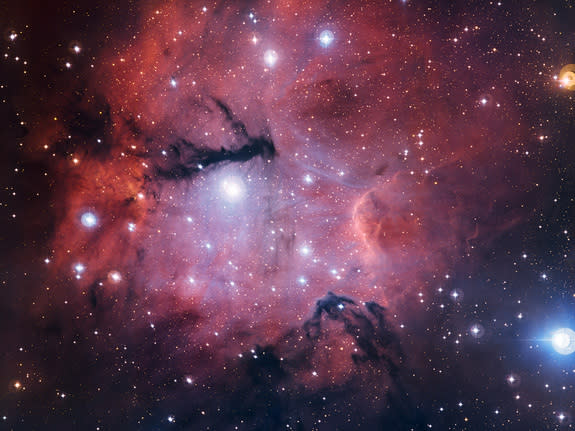Newborn Stars Will Rip Apart Their Stellar Womb (Video, Photos)
Massive young stars that will eventually destroy their own stellar nursery shine brightly in a dazzling new photo.
Cosmic gas cloud Gum 15, which lies 3,000 light-years from Earth, is busily giving birth to huge stars that are, in turn, shaping the cloud's weird structure. That activity will eventually lead to the nebula's death, according to representatives with the European Southern Observatory (ESO), which released a new video showing the doomed nebula today (July 2).
The cloud consists of a collection of ionized hydrogen gas (also known as HII), hydrogen atoms whose electrons were stripped by ultraviolet light. It also includes one of the "culprit" stars in the future murder: HD 74804, a star visible at the center of the new image.
"Once the newly minted stars have passed through their infant stages, strong winds of particles will stream away from these large stars, sculpting and dispersing the gases around them," ESO officials wrote in a statement.
"When the most massive of these stars begin to die, Gum 15 will die with them," the researchers added. "Some stars are so large that they will go out with a bang, exploding as supernovae and dispersing the region's last traces of HII, leaving behind just a cluster of infant stars."
Astronomers believe stars form in massive clouds of material such as this one, which are known as nebulas. Hydrogen is the most abundant element in the cosmos, and is found in Earth's own sun (along with helium, which is produced as the sun fuses hydrogen in its core).
Gum 15 is an example of a so-called "HII region." It is one of many irregular shapes spotted by scientists around the cosmos. The nebula's weird design comes from its irregular distribution of gas and dust, ESO stated.
Other famous examples of HII regions are found in the Eagle Nebula (home of the famous "Pillars of Creation" captured by the Hubble Space Telescope) and the Orion Nebula.
ESO captured the new image using the Wide Field Imager on the MPG/ESO 2.2-meter (7.2 feet) telescope at the La Silla Observatory in Chile. Gum 15 is located in the southern constellation Vela (the Sails). Gum gets its name from Australian astronomer Colin Gum, who created a catalogue of HII regions published in 1955.
Follow Elizabeth Howell @howellspace, or Space.com @Spacedotcom. We're also on Facebook and Google+. Originally published on Space.com.
Copyright 2014 SPACE.com, a TechMediaNetwork company. All rights reserved. This material may not be published, broadcast, rewritten or redistributed.

 Yahoo News
Yahoo News 

